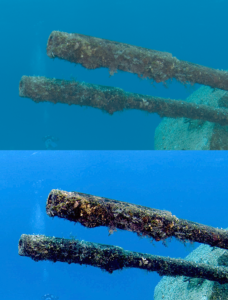Your cart is currently empty!
Lookin’ Sharp!

Have you noticed that your underwater images aren’t always as sharp as what you are used to seeing topside? That’s probably because the water scatters the light bouncing off your subject.
If you don’t want to loose any sharpness due to light scattering, you’ll need to capture your photos in a vacuum. Probably not very practical, and doubtful that your subjects would like it in any case. In air or water, there will always be some redirection of photons by the molecules in between your camera and your subject. The effect is more noticeable in water than air, due to the greater density of the water. The Pros always say, “Get close,” and minimizing the light scattering is another reason to do so.
But fish are notoriously bad at posing, making it difficult to get in close enough for the shot you want. So what can you do, even though you did your best? All is not lost…you can post-process your images to sharpen them.
What the process of sharpening does is accentuate differences between adjacent or nearby pixels. Let’s say you have a pixel that is nearly black next to one that is nearly white. When it is unleashed, the sharpening filter picks through your image and finds these pixels. “Ah-hah!,” says the filter, “This is a big difference. It must be an edge. I’ll do my thing.”
Then the sharpening filter proceeds to make the nearly black pixel a little blacker, and the nearly white pixel a little whiter. The amount of change depends on the settings chosen. What you see when you look at the new image is that the difference between the nearly black and nearly white pixels (and others like them) is a little greater, and the image seems to “pop” a little more.
But you have to be careful. This is not one of those situations where if a little is good, too much is just right. Too much sharpening can be as bad or worse than none at all. So choosing the right amount of added sharpness is important.
In Picture-Fix, we select a level of sharpening that works for most underwater snapshots. And we also allow you to modify those selections according to your needs. How can you tailor the sharpening to your needs? More on that next time.
